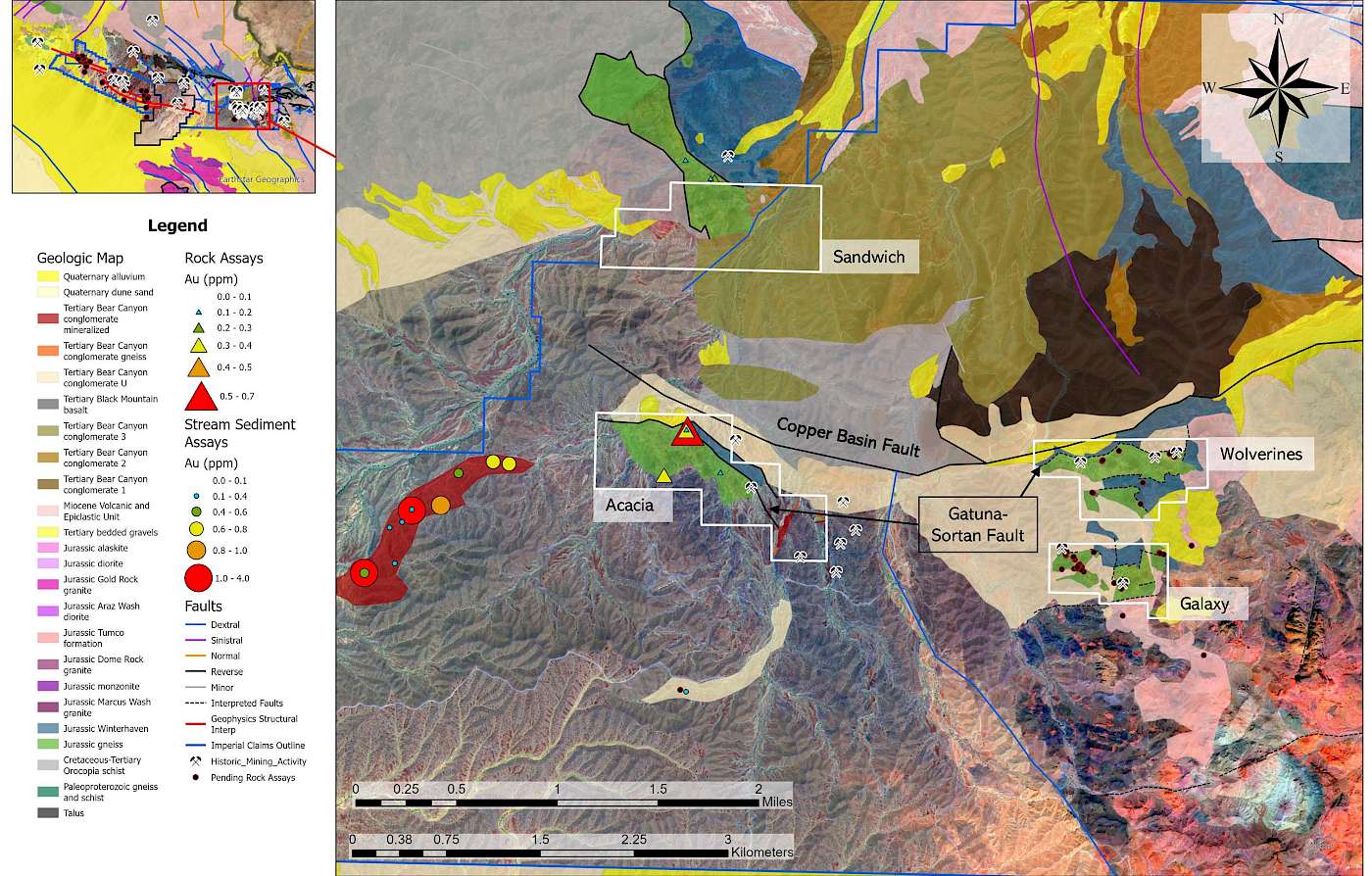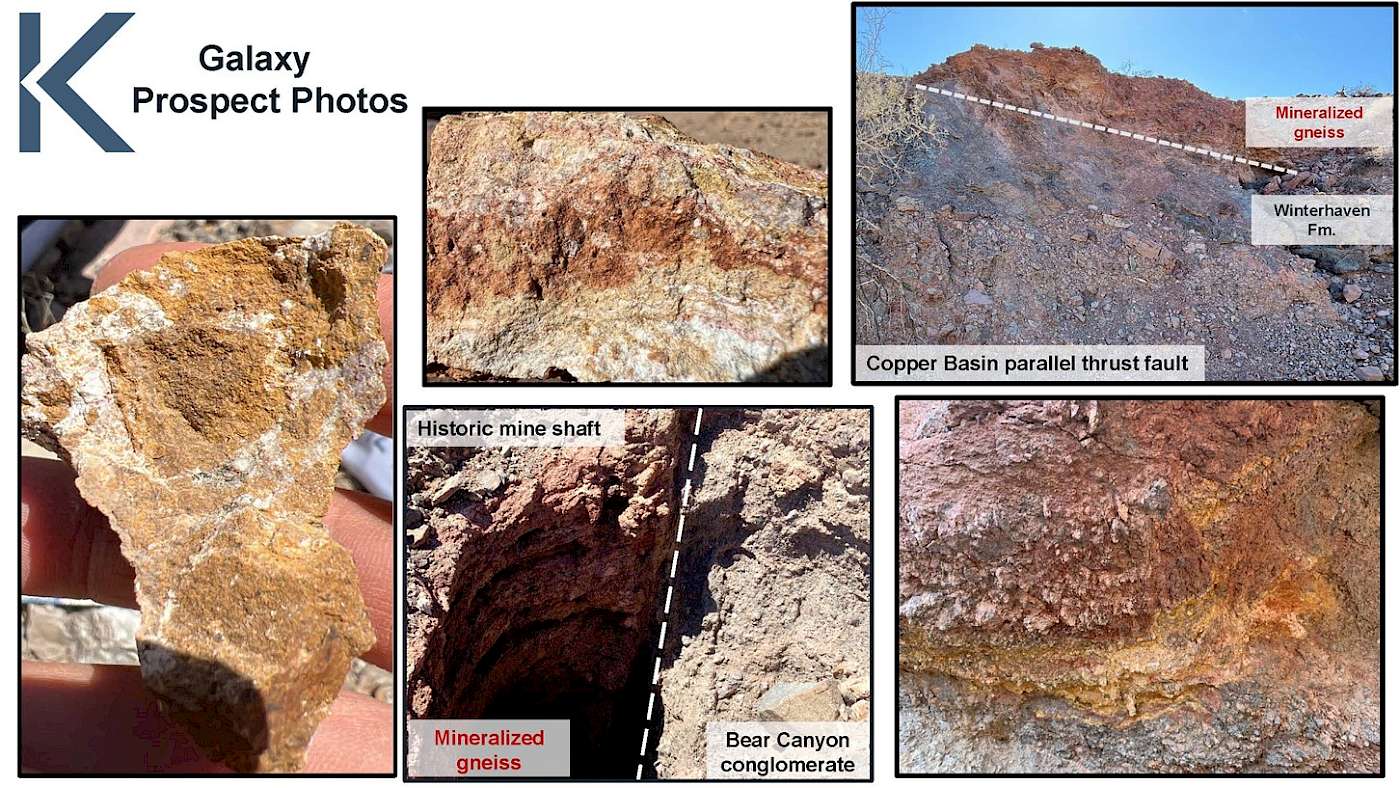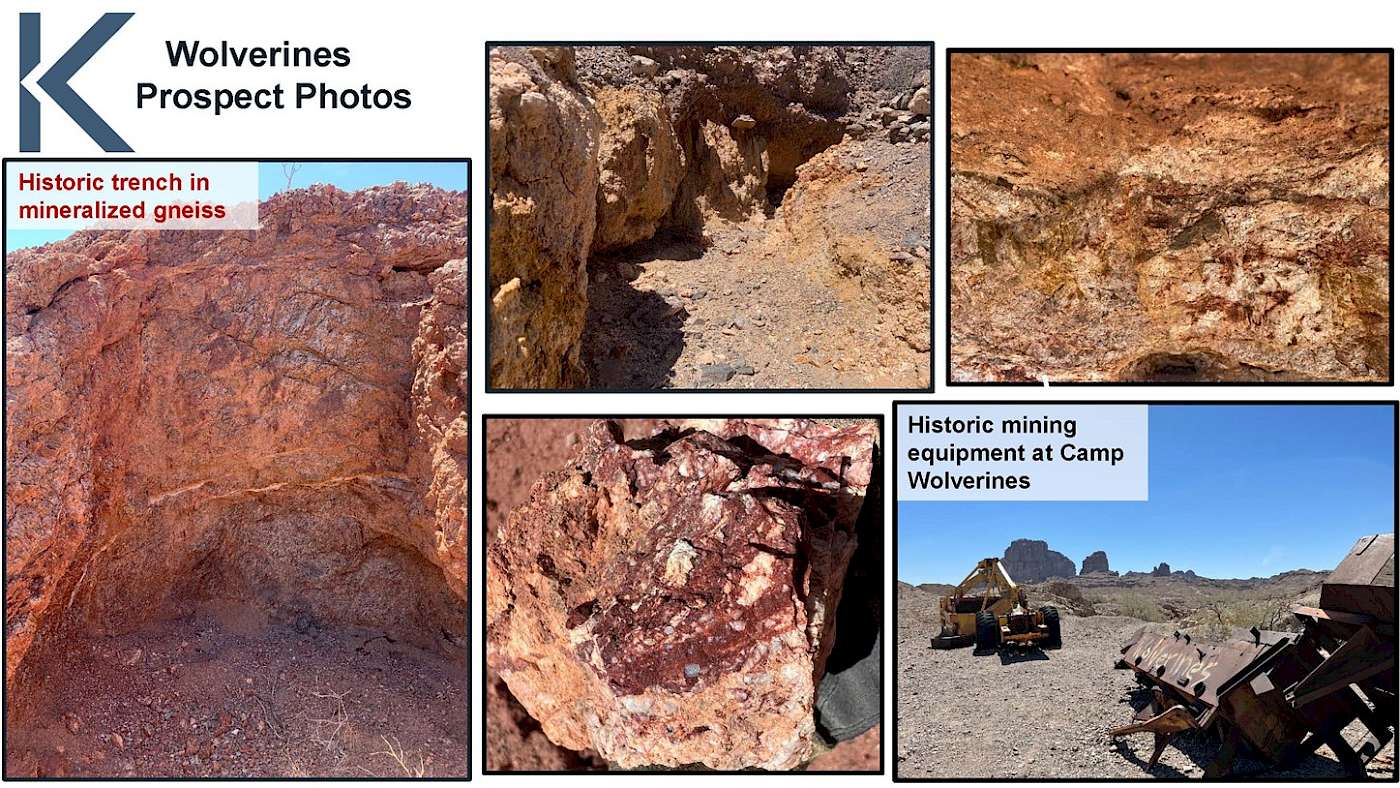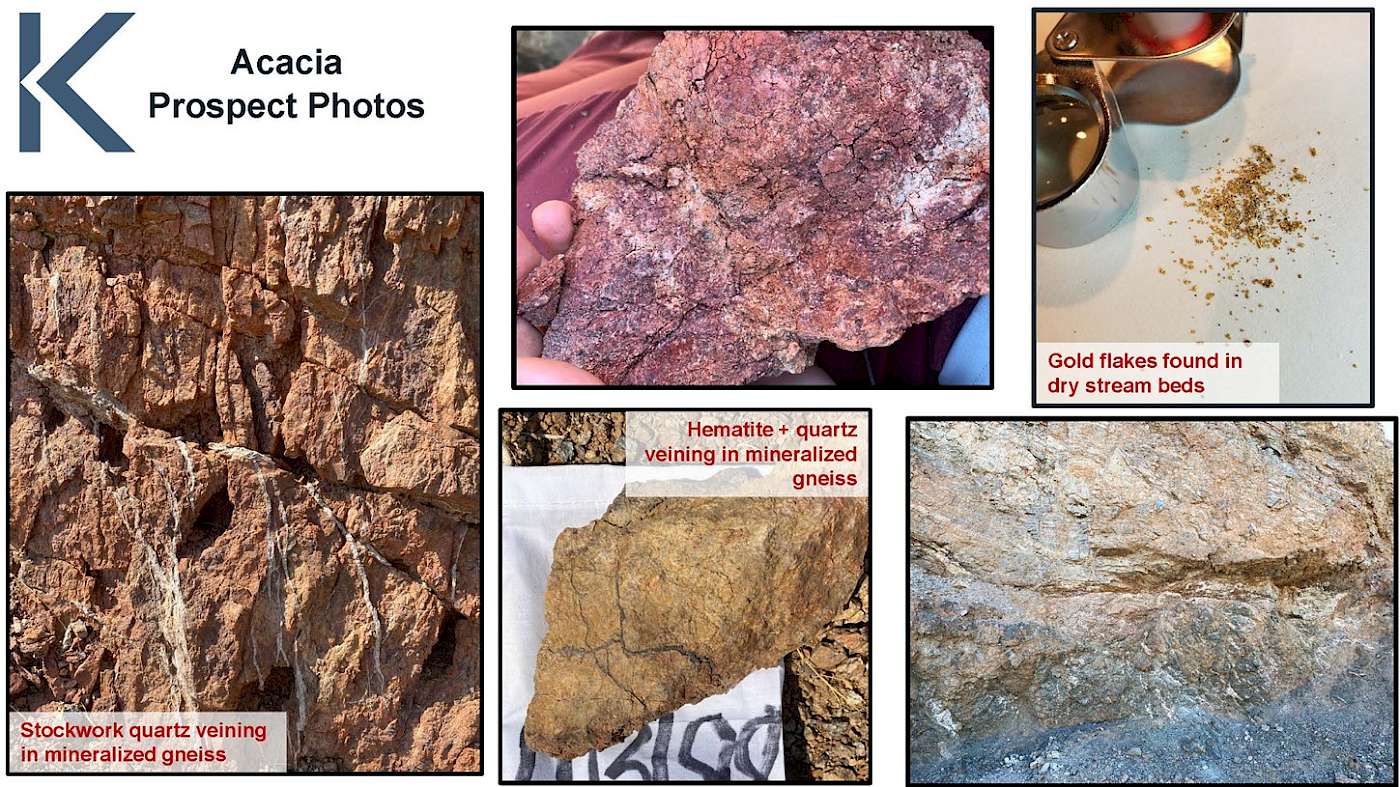News
KORE Mining Discovers Another New Prospect and Now Has Eight km of Potential Strike in Four Targets East of the Imperial Gold Project
April 26, 2022
More Regional Exploration Assays and Analyses Pending
Vancouver, BC April 26, 2022 - KORE Mining Ltd. (TSXV: KORE | OTCQX: KOREF) (“KORE” or the “Company”) is pleased to announce the continued expansion of the Imperial Gold Project (“Imperial”) through the recent discovery of a fourth outcropping prospect named “Galaxy”. In total, the Company now has ten highly prospective drill targets identified in the overall Mesquite-Imperial-Picacho District (“District”) that captures 28 kilometers (“km”) of prospective ground from Equinox Gold’s (TSX: EQX) operating Mesquite gold mine (“Mesquite”) to the historic Picacho gold mine (“Picacho”).
With Galaxy, KORE now has an inventory of four prospect areas totalling 802 acres and containing 8 kilometers of total strike (Figure 1) east of Imperial towards Picacho. This release summarizes these four eastern targets and demonstrates their potential to host additional discoveries in this prolific gold mining jurisdiction. Additional analyses and assays are pending from across the District.
Eastern Area Target Highlights:
| Target Area | Strike Length | Width | Area (acres |
Assay Highlights |
| Acacia | 1.3 km | 0.5 km | 278 | 3.7 g/t ss, 0.6 g/t rc |
| Sandwich | 0.6 km | 0.7 km | 260 | 0.2 g/t rc |
| Galaxy | 1.0 km | 0.6 km | 108 | 30 assays pending |
| Wolverines | 1.8 km | 0.6 km | 170 | 14 assays pending |
ss = stream sediment sample rc = rock chip sample
KORE’s CEO Scott Trebilcock commented, “The large target areas, historic mine workings and similar outcropping rock types to the Imperial and Mesquite deposits give us confidence in making new discoveries in the structurally connected Mesquite-Imperial-Picacho District. Out field team continues to work our huge land package which now needs to be prioritized for our next drill permit application.”
In 2021, KORE commissioned a property-wide multispectral WorldView-3 alteration mapping survey which provided imagery that, in addition to boots-on-the-ground field work, has greatly accelerated the rate of new discoveries by highlighting prospective areas. The massive 31,000 acre District claim area has taken hundreds of person-days to follow-up anomalies with mapping and sampling. From the hard work of our exploration team, the Company is starting to define some of the District potential. Additionally, having the intact Imperial deposit and the exposed Mesquite deposits to “tune” or “fingerprint” exploration targeting methods greatly enhances the Company’s confidence to target new discoveries along the 28 km District trend.
Galaxy Target Area
The newly identified Galaxy prospect is KORE’s newest find was discovered March 2022 during reconnaissance mapping efforts. Galaxy consists of five structurally dismembered gneiss outcrops totalling 108 acres. This target is characterized by alteration styles analogous to the Imperial deposit thus is highly prospective for gold (Figure 2). Historic mining activity is prevalent at Galaxy, including shafts up to 100 feet deep, declines, and trenches that target mineralized south-dipping thrust faults. This structural setting is consistent with highest grade portion of the Imperial deposit. 30 rock samples have been collected to date with assay results expected June 2022.
Galaxy is intersected by the Gatuna-Sortan fault, which yielded outcrop assays as high as 0.6 g/t in the Acacia target area. This fault juxtaposes the relatively impermeable Winterhaven formation above the Jurassic gneiss, which likely acted as a lithocap to ascending gold-bearing hydrothermal fluids. Observed alteration styles include fracture hosted to pervasive iron oxides, silica, sericite, chlorite, kaolinite, and quartz+carbonate veining. Sampling is ongoing and is expected to be completed May 2022.
Wolverines Target Area
Since its initial discovery in October 2021, roughly 80 acres of outcropping gneiss have been added to the Wolverines prospect, nearly doubling its size. These outcrops consist of strongly altered and brecciated gneiss and frequently display quartz+carbonate veining (Figure 3). To date, Wolverines totals 1.7 km of prospective strike length. Assay results from 14 rock samples are expected June 2022.
The Wolverines target is along the Copper Basin fault, a regionally extensive E-W trending thrust fault. Similar to Acacia and Galaxy, Wolverines also encompasses a portion of the Gatuna-Sortan fault.
Multiple anomalies from SWIR Geo Enhanced satellite imagery and spectral alteration mapping remain to be tested. Additional sampling is ongoing.
Sandwich Target Area
The Sandwich zone prospect displays numerous large slot canyons and cliffy exposures of mineralized gneiss outcrop (Figure 4). This target area has a strike length of 1.4 km and mineralization is structurally controlled by regionally extensive WNW trending thrust faults. The intensity of the alteration correlates with the degree of brecciation of the host rock, with more rheologically brittle rocks serving as better hosts. Mineralized veins are observed in the stratigraphically overlying Winterhaven Formation.
This prospect area is dismembered by a large-offset strike slip fault, which transported a sliver of mineralized basement 1.5km to the south creating the “Acacia” target area.
Acacia Target Area
The Acacia target area is characterized by the prevalence of gold flakes and nuggets. Sampling in this prospect has yielded assays as high as 3.7 g/t, which are among the highest on the property. Mapping efforts have delineated a 1.8km intensely brecciated and altered gneiss outcrop (Figure 5).
The Acacia target is a faulted sliver of the Sandwich zone transported via the dextral Gatuna Wash fault. The mineralization in both zones is controlled by E-W trending regionally extensive thrust faults, namely the Gatuna-Sortan, Chocolate Mountains, and Copper Basin fault systems.
KORE is committed to operating within the stringent environmental and labour standards of California.
About the Imperial Gold Project
KORE owns 100% of the Mesquite-Imperial-Picacho District which consists approximately 31,000 acres of claims capturing the entire 28-kilometer trend from the operating Mesquite mine (Equinox Gold - TSX:EQX) to the closed Picacho mine and including KORE’s Imperial project as depicted on Figure 3. In the District, gold is hosted in local fault structures related to a series of regional faults connecting the known District deposits. Those three District deposits (Mesquite, Imperial and Picacho) were discovered in exposed outcrops and from placer workings. The rest of the District is covered by alluvium and has never been systematically explored.
The Mesquite-Imperial-Picacho District centers on KORE’s Imperial project. Imperial is a structurally controlled orogenic gold deposit. The 100% oxide gold deposit is currently defined at 2.44 km long and up to 0.75 km wide and is open both along strike and down dip. It is hosted in a shallowly southwest dipping, amphibolite grade metamorphic rock suite along a west- northwest trending low-angle regional thrust fault system which controls the regional geometry of mineralization. East-west striking, post-mineralization normal faults control the property scale geometry of mineralization. Geophysical characterization of the deposit and regional controlling structures is an essential component of exploration for additional resources.
Imperial has a mineral resource estimate and a positive preliminary economic assessment effective April 6, 2020 with the following highlights:
- Robust economics: US$ 343 million NPV5% post-tax with 44% IRR at US$ 1,450 per ounce gold
- Low capital intensity project with only US$ 143 million pre-production capital cost
- Average 146,000 ounces gold per year over 8 years for 1.2 million ounces total production
- Technically simple project: shallow open pit, run-of-mine heap leach with existing infrastructure
- Value enhancement through Mesquite-Imperial-Picacho District exploration and resource expansion
The Company’s NI 43-101 compliant resource and preliminary economic assessment is titled “Preliminary Economic Assessment – Technical Report Imperial Gold Project” effective as of April 6, 2020 and revised and amended on June 10, 2021, prepared by Terre Lane and Todd Harvey of Global Resource Engineering and Glen Cole of SRK Consulting (Canada) Inc. can be found under the Company’s profile on SEDAR (www.sedar.com) and on the Company’s website.
About KORE Mining
KORE Mining is focused on responsibly creating value from its portfolio of gold assets in California, USA. The Company is advancing the Imperial project towards development while continuing to explore across both district-scale gold assets. Management and Board, along with strategic investor, Eric Sprott (26% owner), are aligned with all KORE shareholders with the goal of creating per share value.
Further information on Imperial and KORE can be found on the Company’s website at www.koremining.com or by contacting us as moc.gninimerok@ofni or by telephone at (888) 407-5450.
On behalf of KORE Mining Ltd
”Scott Trebilcock”
Chief Executive Officer
(888) 407-5450
Investor Relations
David Jan
1-888-407-5450
moc.gninimerok@ofni
Technical information with respect to the District and Imperial Gold Project contained in this news release has been reviewed and approved by Marc Leduc, P.Eng, who is KORE's COO and is the qualified person under National Instrument 43-101 responsible for the technical matters of this news release.
Neither the TSX Venture Exchange nor its Regulation Services Provider (as that term is defined in the policies of the TSX Venture Exchange) accepts responsibility for the adequacy or accuracy of this release.
Cautionary Statement Regarding Forward-Looking Information
This news release contains forward-looking statements relating to the future operations of the Company and other statements that are not historical facts. Forward-looking statements are often identified by terms such as "will", "may", "should", "anticipate", "expects", “intends”, “indicates” and similar expressions. All statements other than statements of historical fact, included in this release, including, without limitation, statements regarding the future plans and objectives of the Company are forward- looking statements.
Forward‐looking statements in this news release include, but are not limited to, statements with respect to: the strategy, timing and implementation of permit regional exploration drilling in the 28-kilometer Mesquite-Imperial-Picacho District (“Regional Exploration Drilling”); the timing of submitting Environmental Assessment report(s) for one or more areas of the Imperial project; potential actions, behavior or position of the Bureau of Land Management (the “BLM”); the underexplored and prospective nature of the Imperial Regional Exploration Drilling area; the results of the preliminary economic assessments for the Imperial Project, including future project opportunities, the projected NPV, permit timelines, the current mineral resource estimate, and the ability to obtain the requisite permits; the market and future price of and demand for gold; the opportunities of expansion at the Imperial Project; and the ability to work cooperatively with stakeholders, including all levels of government. Such forward‐looking statements, and any assumptions upon which they are based, are made in good faith and reflect our current judgment regarding the direction of our business. In connection with the forward‐looking information contained in this presentation, the Company has made numerous assumptions, including, among others: there being no significant change to current geotechnical, metallurgical, hydrological and other physical conditions at the Imperial Project; exploration, permitting, and development of the Imperial Project being consistent with current expectations and planning; the geological, permitting and economic advice that the Company has received is reliable and is based upon practices and methodologies which are consistent with industry standards; and other planning assumptions. While the Company considers these assumptions to be reasonable, these assumptions are inherently subject to significant uncertainties and contingencies.
Forward-looking information involves known and unknown risks, uncertainties and other factors which may cause the actual results, performance or achievements of the Company to be materially different from any future results, performance or achievements expressed or implied by the forward‐looking information. Known risk factors include, among others: the outcome of BLM’s review processes for permitting, including the final outcome(s) of BLM’s mineral claim validity examination(s) and administrative review process(es) with respect to the Imperial Zone, including a change to the findings from the mineral claim validity examination conducted in 2002 for the mill sites at the Imperial Zone, resulting in the Company having to move its future Imperial Zone project support facilities to areas that are not within the Indian Pass mineral withdrawal area; the possibility that BLM may require and/or conduct further mineral claim validity examinations with respect to the Imperial project, and the outcome and final determination of such examination could, among other things, invalidate one or more mining claims; the possibility that BLM or other governmental authority review of the Regional Exploration Drilling program, delays or changes the Company’s plan for Regional Exploration Drilling permitting, which could result, among other things, in delays, additional project requirements, additional costs and uncertainty of meeting anticipated program milestones; the exploration drill program may not be completed as planned; the need to obtain additional financing; uncertainty as to the availability and terms of future financing; the possibility of delay in exploration or development programs and uncertainty of meeting anticipated program milestones; uncertainty as to timely availability of permits and other government approvals.
Additional risks and uncertainties are described in the “Risks” sections of (i) the Company’s Annual Information Form for the year ended December 31, 2020 prepared as of April 29, 2021, and (ii) the Company’s Management’s Discussion and Analysis for the nine months ended September 30, 2021, both available under the Company’s issuer profile on www.sedar.com.
Forward-looking statements contained herein are made as of the date of this news release and the Company disclaims any obligation to update any forward-looking statements, whether as a result of new information, future events or results, except as may be required by applicable securities laws. There can be no assurance that forward-looking information will prove to be accurate, as actual results and future events could differ materially from those anticipated in such statements. Accordingly, readers should not place undue reliance on forward-looking information.
There is no certainty that all or any part of the mineral resource will be converted into mineral reserve. It is uncertain if further exploration will allow improving the classification of the Indicated or Inferred mineral resource. Mineral resources are not mineral reserves and do not have demonstrated economic viability.
FIGURE 1: Geologic Map of Eastern Area Prospects
FIGURES 2-5: Prospect Area Photos





